|
|
Post by another specialist on Dec 5, 2006 10:43:01 GMT
EASTERN BETTONG Bettongia gaimardi ssp. gaimardi Bettongia gaimardi gaimardi was endemic to Australia. It was last recorded in 1910. The eastern bettong was associated with grassland areas, heathlands, and sclerophyll woodland. Causes of the extinction of this animal are cited as competition with introduced rabbits for burrows and food, habitat disruption and disturbance by livestock, predation by foxes, and direct killing by people. |
|
|
|
Post by another specialist on Dec 5, 2006 11:32:40 GMT
Tasmanian bettong Surviving in Tasmania Of the four bettong species, two still occur in mainland Australia; the other two only survive on neighbouring islands. The Tasmanian bettong Bettongia gaimardi( Desmarest, 1822) is doing rather well in Tasmania. It is not threatened by foxes and there is little competition by rabbits, which are not as numerous as they are on the mainland. The subspecies that lived in south-eastern Australia, however, became extinct in the beginning of the 20th century. The Tasmanian bettong is a nocturnal, rabbit-sized animal, which feeds mainly on underground fungi, seeds, roots and bulbs. It makes a dense, ovoid nest of grass and bark, situated in a small depression in the soil which the animals dig themselves. Nesting material is carried with the tail. Breeding is more or less continuous, with two or three births (of a single young) every year. The young leaves the pouch after about 105 days, only to make place for the new arrival. 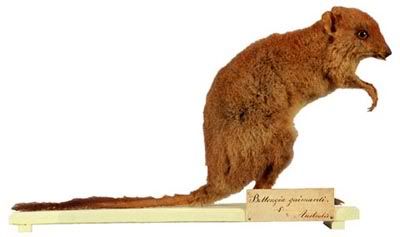 Tasmanian Bettong Different causes of exctinction Apart from the introduction of the fox in Australia and rabbits destroying the grasslands which the bettong needed for cover, cattle-grazing and cultivation of grasslands may have been other causes of extinction. However, in Tasmania the species also manages to survive in dry, open forests with a grassy understorey. 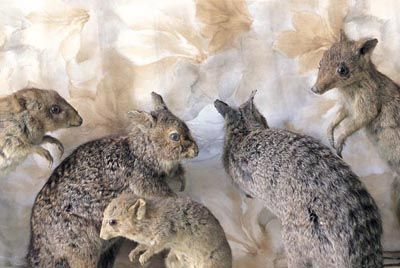 Tasmanian Bettong Photograph by Rosamond Purcell from Swift as a Shadow. © 1999. The museum collection The National Museum of Natural History possesses six 19th-century mounts of the Tasmanian bettong. Three of those, two males and a female, belong to the extinct mainland form Bettongia gaimardi gaimardi. One of the males was purchased in 1844 from the Amsterdam dealer G.A. Frank, the provenance of the other two specimens is unknown. www.naturalis.nl/300pearls/ |
|
|
|
Post by another specialist on Dec 6, 2006 15:19:47 GMT
|
|
|
|
Post by another specialist on Sept 10, 2007 11:39:41 GMT
|
|
|
|
Post by another specialist on Sept 10, 2007 11:59:16 GMT
Victoria Museum has several specimens dating Upper Yarra 1877, Goulburn 1861 and two others dated 1867 and 1869. 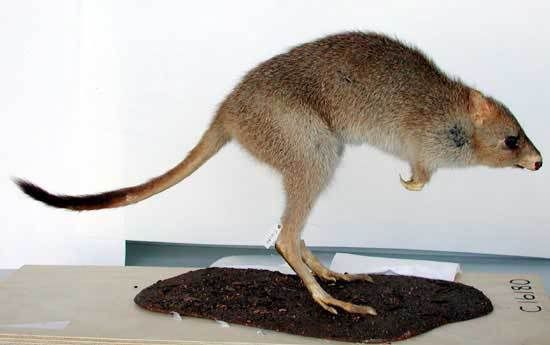   Mount of an Adult Tasmanian Bettong Bettongia gaimardi  Specimen Reg. No. C 2450 Hind foot from below, of a Tasmanian Bettong Bettongia gaimardi Photo by Ken Walker © Museum Victoria www.museum.vic.gov.au/ |
|
|
|
Post by another specialist on Sept 10, 2007 12:03:49 GMT
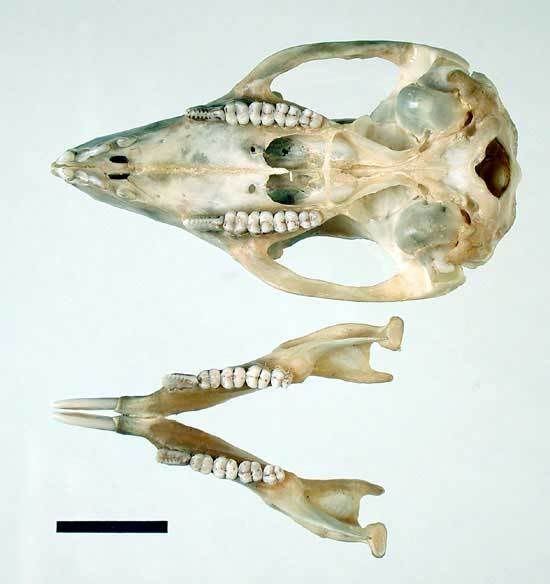 Interior head, showing skull from underneath and the jaw from above, of a Tasmanian Bettong Bettongia gaimardi Specimen Reg. No. C 11375. Locality: 24km North of Bothwell, Tasmania Scale line equals 2cms.  Exterior head, showing skull from above and jaw from below, of a Tasmanian Bettong Bettongia gaimardi Specimen Reg. No. C 11375. Locality: 24km North of Bothwell, Tasmania Scale line equals 2cms. 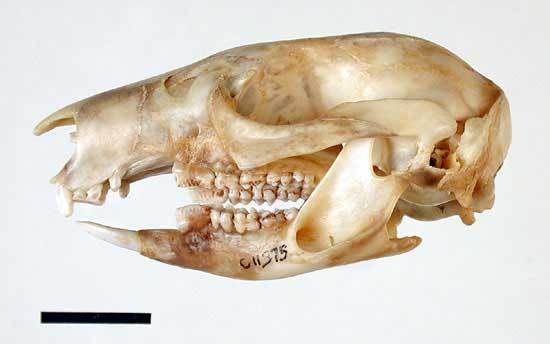 Head, showing skull and jaw side on, of a Tasmanian Bettong Bettongia gaimardi Specimen Reg. No. C 11375. Locality: 24km North of Bothwell, Tasmania Scale line equals 2cms. Photo by Marnie Rawlinson, Cathy Accurso and Ken Walker © Museum Victoria www.museum.vic.gov.au/ |
|
|
|
Post by another specialist on Dec 20, 2007 12:47:16 GMT
|
|
|
|
Post by another specialist on Jan 6, 2008 21:25:47 GMT
|
|
|
|
Post by another specialist on Jul 9, 2008 3:59:39 GMT
Bettongia gaimardi Author: Desmarest, 1822. Citation: Mammalogie. In Encycl. Méth., 2(Suppl.): 542. Common Name: Eastern Bettong Type Locality: Australia, New South Wales, Port Jackson. Distribution: Formerly coastal SE Queensland and N New South Wales, south to SW Victoria; now extinct on mainland Australia; survives in Tasmania. Status: CITES – Appendix I; U.S. ESA – Endangered; IUCN – Extinct as B. g. gaimardi, otherwise Lower Risk (nt). Comments: See Corbet and Hill (1980:16). www.bucknell.edu/msw3/browse.asp?s=y&id=11000180 |
|
|
|
Post by another specialist on Oct 11, 2008 9:44:25 GMT
Taxonomy [top] Kingdom Phylum Class Order Family ANIMALIA CHORDATA MAMMALIA DIPROTODONTIA POTOROIDAE Scientific Name: Bettongia gaimardi Species Authority Infra-specific Authority: (Desmarest, 1822) Common Name/s: English – Tasmanian Bettong, Eastern Bettong, Tasmanian Rat Kangaroo French – Kangourou-rat De Gaimard, Kangourou-rat De Tasmanie Spanish – Canguro-rata De Tasmania Assessment Information [top] Red List Category & Criteria: Near Threatened ver 3.1 Year Assessed: 2008 Assessor/s Menkhorst, P. Evaluator/s: Lamoreux, J. & Hilton-Taylor, C. (Global Mammal Assessment Team) Justification: Listed a Near Threatened because, although it is considered to be common on Tasmania, the recent introduction of the Red Fox has the potential to be a major threat to this species in the future. The Tasmanian Bettong is thought to have been eliminated from mainland Australia by introduced foxes, and if fox control measures are not successful on Tasmania, this species could face a significant decline in the next ten years (but unlikely to be as great as 30%), thus making the species close to qualifying for Vulnerable under criterion A. History: 1996 – Lower Risk/near threatened (Baillie and Groombridge 1996) Geographic Range [top] Range Description: This species is endemic to Australia. There are two subspecies recognised: Bettongia gaimardi gaimardi is presumed to be extinct. It was formerly distributed throughout much of the south-eastern Australian mainland, as far north as south-eastern Queensland, but disappeared around the 1920s.B. g. cuniculus is widespread in eastern Tasmania from sea level up to 1,000 m (Maxwell et al. 1996). Countries: Native: Australia Population [top] Population: It is presumed to be extinct on the Australian mainland, but it is common on Tasmania (Rose and Johnson 2008).Population Trend: Stable Habitat and Ecology [top] Habitat and Ecology: It is found in well drained, open eucalypt or Casuarina forests and woodlands with grassy or heathy ground cover. Breeding is continuous and the females may produce two or three young per year (Rose and Johnson 2008). Systems: Terrestrial Threats [top] Major Threat(s): This species is threatened by land clearing (through timber harvesting) and excessive grazing of stock. Repeated use of 1080 poison for wallaby control on private land and the recent introduction of foxes both adversely affect the species. Conservation Actions [top] Conservation Actions: It is present in some protected areas. Recommended conservation actions (Maxwell et al. 1996) include: reserve suitable dry sclerophyll habitats; maintain open habitat through appropriate fire management; continue monitoring abundance at selected sites throughout range; identify populations vulnerable to 1080 and implement measures to reduce its use in those districts; educate landowners on minimal use of 1080 and land clearing. www.iucnredlist.org/details/2783 |
|
Deleted
Deleted Member
Posts: 0
|
Post by Deleted on May 2, 2009 18:29:06 GMT
I don't get it, are those subspecies now still recognized or not  |
|
|
|
Post by another specialist on May 2, 2009 19:01:51 GMT
Generally not recognised by many.
|
|
|
|
Post by surroundx on Apr 5, 2017 13:49:32 GMT
|
|
|
|
Post by surroundx on Apr 15, 2017 4:24:37 GMT
|
|